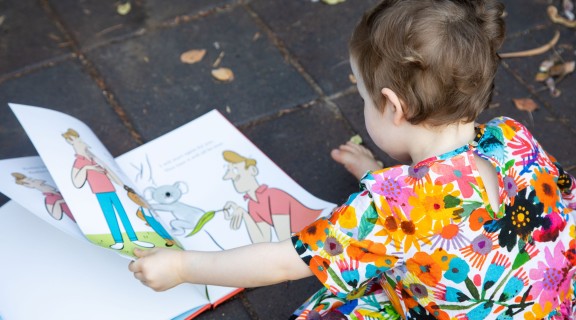
All the ways to share a story
13 October 2021 | State Library of Queensland
For little ones, sharing a story with you is so much more than reading the words on the page. To make the most of the time that you have to share books with you child, there are plenty of aspects that you can focus on, and they all have real benefits for your child’s reading future – plus, they can make the requested repeated readings of the same book much more interesting for you! For very young children, sharing a story means looking at the pictures to understand the plot as you read; using different voices to act out the characters or describe what they see; retelling the story in their own words or making it up along the way. For our littlest book lovers, learning to read the words comes later. First, there are...
The Pictures
Starting with the cover, pictures draw a child into a story. They are the visual cues to what the story is about. Just as we adults gather and make meaning every day through images, diagrams, GIFs, emojis, signs and symbols, children use pictures to understand the characters and what is happening in the story.
So, before you read a story aloud, take a ‘picture walk’ with your little one and discover the story through the pictures first. You can have lots of fun making observations together and connecting the pictures to the words. Ask your child to find an object on the page. What letter does it start with? What other words start with this letter?”
So much learning can happen before you’ve read a word!
Pictures also convey emotions so explore how the characters in the story may be feeling. “This crocodile looks very sad. I wonder if he is hungry? What do you think crocodiles like to eat?” By asking questions, you are extending the story, building context and supporting your child’s creative thinking and language skills as they find the words to respond.
Through pictures, you can also reminisce and share your own experiences with your child. For example, talk about what happens in the story - is it the same or different from what happens in your family? “Remember when we went to the zoo and saw a crocodile?” These positive interactions through shared experiences are important for bonding and healthy brain development.
The Story Retelling
When children retell stories in their own words, they’re exercising their memory and strengthening their understanding of the story. When stories are told in predictable patterns, children are better able to attach meaning, problem solve and make connections - they’re building their language and understanding skills. Enjoy listening and responding to your child as they share their own stories that have a beginning, a middle and an end, embellished by their own imagination.
The Letters
As children learn to recognise that letters make sounds, they’re strengthening their awareness of print and how it works. You can help them by pointing out the different words and letters on the page. Demonstrate how they go from left to right. Trace around the shapes of the letters with your finger. You can also talk about upper and lower case letters or the symbols that also convey meaning like exclamation and question marks. By doing these simple things you’re helping your child learn about language.
It’s the beginnings of your child’s literacy journey!
So, next time you share a story together take a ‘picture walk’ first and take time to talk about letters sounds. Then, take a listen to the story through the words of your child. Who knows what will happen next?!
Comments
Your email address will not be published.
We welcome relevant, respectful comments.